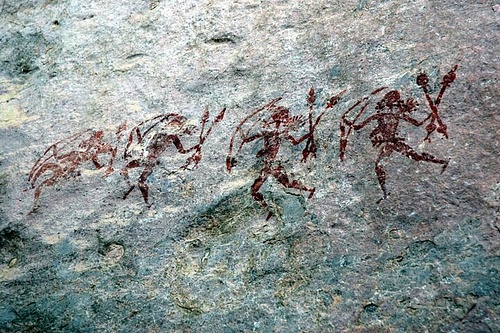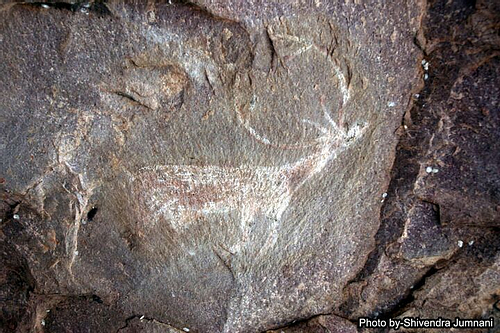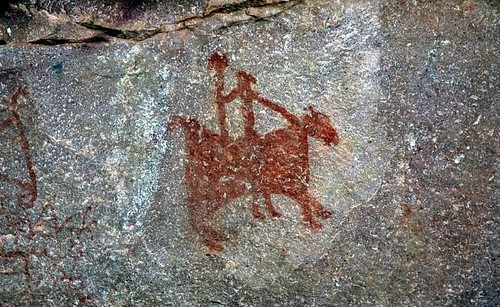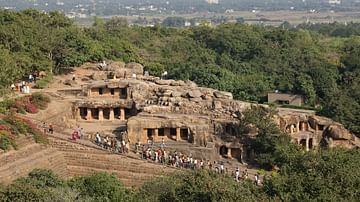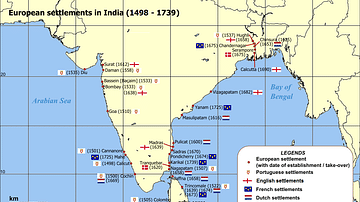Rock art, that is paintings and carvings on natural rock formations, is one of the earliest forms of creative expression and a universal phenomenon among prehistoric societies. An instrument of communication rather than simply art, it is an assemblage of material culture which provides a glimpse into the lives of people who painted them. Art is a powerful tool to express oneself, and rock art is a window into the prehistoric mind as the paintings reflect imagination, creativity, emotions, and tenderness. Rock art is the primary source to study the culture, rituals, traditions, and lives of prehistoric societies. In a multidisciplinary approach, scientists attempt to date the paintings while artists seek the meaning behind them.
There are three distinct categories of rock art:
- Petroglyphs: carvings, sculpting or engravings on the surface of the rock.
- Pictographs: paintings or drawings on rocks and the inside of the rock shelters.
- Petroforms: designs, patterns or sculptures made by aligning or stacking rocks.
Rock Paintings in India
The range of rock art available in India is both wide and varied in terms of style and theme. Its chronology can be traced from the Upper Paleolithic era to historic times and little glimpses of today's tribal communities can be found. In India, remains of rock paintings were found on the walls of caves located in several districts such as Madhya Pradesh, Uttar Pradesh, Andhra Pradesh, Telangana, Kerala, Uttarakhand, Bihar, and Karnataka. Central India is the richest region of rock art, with the highest concentration situated in Kaimur hills, Satpura, and Vindhyas. These hills are formed of sandstone, with the rock shelters situated in the dense forest area. These were occupied in the Stone Age and in the later periods as they were ecologically ideal. Several paintings of Central India resemble the style of Neolithic paintings of Rhodesia, Eastern Spain, South Africa, and Australia. The paintings depict hunting, battles, dancing scenes, and different human and animal figures.
In 1867-68 CE, English archaeologist Archibald Carlleyle discovered prehistoric rock paintings in India, twelve years before the recognition of Altamira in Spain. Unfortunately, his discoveries were not published. Carlleyle found paintings on the roof and walls of rock shelters in Sohagighat, in the Mirzapur District. Vishnu Shridhar Wakankar, an eminent archaeologist and Pitamaha or father of Indian rock art, discovered Bhimbetka (a UNESCO World Heritage Site) in 1957 CE. This discovery changed the destiny of rock art in Madhya Pradesh. Later on, extensive efforts to explore the sites in Raisen, Kharwai, Bhopal, Narwar, Chiklod, Amargarh, Bhimbetka, Adamgarh, Nagori-Sanchi, Kathodia, Firangi, Bori, and other Central Indian regions have brought vivid paintings to light. In between Tamia and Pachmarhi, a new group of painted caves has been discovered, which holds lucid similarities to those found in other rock caves of Madhya Pradesh.
Adamgarh - Paintings, Theme & Style
Adamgarh hills are situated 2 km south of Hoshangabad town, near the Narmada river. Adamgarh rock shelters were discovered by Manoranjan Ghosh in 1922 CE, further research was carried out by D.H. Gordon and other archaeologists like Mitra (1927 CE), Silberrad (1932 CE), Brown (1932 CE), and Hunter (1935 CE). There are around 18 rock shelters in Adamgarh; 11 shelters have visible paintings, others have faded with time and some due to vandalism by tourists. The shelters contain mostly miniature paintings and Shelter no. 10 is extremely important because of the superimposition of paintings from different periods.
The paintings are simple, less artistic and, in most cases, without any details of physical proportion. Painted in red, dark brown, shadowy brown, and white, the human figures are pinched merely in outlines, while animal figures have a little more detailing. The activities of human beings and animals have been exceptionally trapped on the walls, which can be well compared with several paintings in Australia, South Africa, Eastern Spain, and South America. Besides battle scenes, riders on horse-back, soldiers with bows and arrows, quiver and scabbard, there are paintings of several animals like oxen, monkeys, horses, fish, peacocks, and in one case a giraffe. Depictions of trees have also been found, but the lack of details makes the identification process difficult.
The Shelters
Shelter No. 1 - This is the smallest shelter but with the depiction of many figures in dark red and red ochre. All paintings have been faded with time, only two are left. One is a depiction of a deer with 12 horns and the other is a realistic painting of a horse in dark grey colour with forelegs in the air.
Shelter No. 2 - Among many faded paintings only two figures are clearly visible. A big spotted deer with long horns is painted on the centre of the back wall in red ochre. In the left corner, a peculiar drawing of an elephant can be found with a scorpion-like trunk with a little curve.
Shelter No. 3 - Two wide-horned cows painted in red ochre are visible. One is mere outlines while the other is solid.
Shelter No. 4 - It is the largest and most spectacular rock shelter in the group. The wall is full of different paintings in red ochre, varying in shade from dark to pale, and the details are vivid and beautiful. The followings are depicted:
- Two men fighting with swords and shields, one sword is leaf-like with unmistakably illustrated ribs.
- A man hunting a bull with bow and arrow.
- A dancing peacock.
- A bull ready to attack, with its horns towards the ground. This painting is 3 meters long and 2 meters wide.
- Soldiers riding on horseback.
Shelter No. 5 - Only one painting drawn in red ochre is visible.
Shelter No. 6 - This shelter has a depiction of a battle scene; men fighting with bows and arrows painted in red and white.
Shelter No. 7 - Three paintings can be found in this shelter, drawn with outlines and the insides are filled with criss-cross lines.
Shelter No. 8 - The red ochre painting depicts three men in a running position.
Shelter No. 9 - This is an enormous rock shelter with very few paintings in white. One depicts a twelve-horned stag and another a horse.
Shelter No. 10 - The paintings in this shelter are well-preserved as they are located high above the ground and on ceilings. Several battle scenes are painted in red ochre and they depict many animal figures such as bulls, horses, and a giraffe, which is quite unusual.
Shelter No. 11 - This is one of the biggest shelters but very few paintings can be seen.
Nagori - An Unprotected Site
The Nagori hill is situated opposite Sanchi hillock about 22 km from Raisen District Headquarters, near Betwa river. This site is recognized as Nagori due to the gigantic image of Naga (snake) in human form. Behind Nagori village, there is a group of rock shelters which belong to the Mesolithic to the medieval period. Paintings of human and animal figures, hunting and battle scenes in red, dark red, and white (and in one case, green) decorate these shelters. There is also a huge unfinished statue of a horse locally acknowledged as Ghodi (Pony).
Nagori also features erotic images, such as a flawlessly drawn pair stroking each other. The erected penis of the man is visibly painted which signifies the pre-copulation posture and the sexual excitement can be scrutinized by the position and posture of two bodies. The curves are natural, exceptionally drawn and well-proportioned.
Conclusion
While some World Heritage Sites such as Bhimbetka, Khajuraho, Sanchi, etc. are in great shape and well-maintained, other rock paintings in Madhya Pradesh need urgent protection. The responsibility of preservation of Adamgarh is controlled by the Central Government Department of Archaeology, and in order to preserve paintings, the department's chemist has ruined them, blemished their beauty and primary charm. Moreover, tourists have tried to draw their own peculiar paintings, immortalizing their visit to a prehistoric place by vandalizing the cultural heritage.
Nagori is an unprotected site, and there are several others similarly neglected in Madhya Pradesh. Manua Bhan ki Tekri, Lal Ghati rock shelters and Shymla hills rock shelters had a great collection of rock paintings, but now only vandalized rocks are left. Paintings should be protected from direct exposure to harsh sunlight and dust, but without protective measures, these sites are becoming more of a ruin than cultural heritage.
This article was submitted as part of Ancient History Encyclopedia's UNESCO Summer School scholarship programme.

